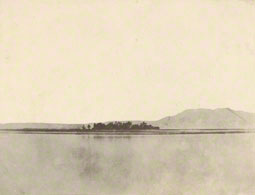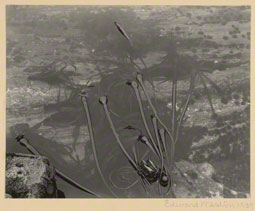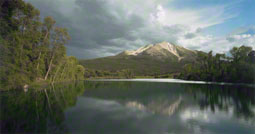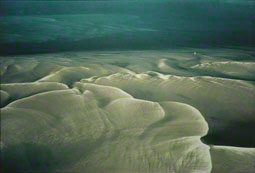|
Nature and photography have been linked since the inception of the medium. Whether driven by the challenge of capturing the expanse and perspective of a vista or by the myriad possibilities of creating a unique artistic experience, the act of depicting the natural landscape has inspired photographers from the 1800s to the present.
Drawn entirely from the J. Paul Getty Museum's collection, this exhibition includes a range of works, from a pre-photographic drawing made with the aid of a camera lucida to a digitally generated print. The installation is divided into three themes: 19th-century technical explorations, the 20th-century turn toward developing a particular camera vision, and the ways that contemporary photographers have framed the landscape to make environmental and conceptual statements.
To create this image, photographer William Garnett piloted his plane over sand bars in Cape Cod. In addition to the natural beauty of the ocean, the photographer invites us to explore space and perception in a unique way. The undulating forms of the sandbars play with the boundaries between foreground and background. Changing tones of blue challenge us to know if we look at water, sky, or even a view from outer space.
|
 |

 |
 |
Thebes, Village of Ghezireh, John Beasly Greene, 1853–54
|
 |
 |
|
|
 |
Histories of photography often begin with an account by William Henry Fox Talbot, who, following a frustrating attempt in 1833 to draw a landscape using a camera lucida, became one of the inventors of photography. In the first decades of the medium, photographing nature involved cumbersome equipment and long exposures. Nevertheless daguerreotypes were praised for their exquisite detail, while early paper prints from paper or glass negatives affirmed photography's place as an art form. With the shorter exposure time and sharpness of the collodion process, the camera was able to record greater perspective.
Photographers traveled far and wide to capture "exotic" landscapes, such as the plains of Egypt and the natural monuments of Yosemite Valley. Archaeologist and photographer John Beasly Greene created this image during his travels on the Nile River, in which the site of the ancient city of Thebes appears on the horizon as a kind of mirage. The textured surface of the salted paper print enhances the mottled surface of the water. The resulting scene is spare and modern in its mood, with time and image blurred before our eyes.
|
 |
 |

 |
 |
Kelp on Tide Pool, Point Lobos, Edward Weston, 1939. © 1981 Arizona Board of Regents, Center for Creative Photography
|
 |
 |
|
Hence the photographer's most important and likewise most difficult task is not learning to manage his camera, or to develop, or to print. It is learning to see photographically.
—Edward Weston, The Complete Photographer, January 20, 1943.
Rather than depicting a traditionally picturesque vista or capturing accurate perspective, photographers of the 20th century began to explore the various but particularly photographic ways that the natural world could be seen through the camera lens. Often this led to spatial experimentation.
Taken at Point Lobos in California, this image by Edward Weston plays with the perception, and misperception, of space. The photographer cropped his photograph of a tide pool to show kelp puncturing the water's surface in the foreground, while in the upper register an underwater landscape appears simultaneously near and far.
|
 |

 |
 |
Mountain IV, Clifford Ross, 2004. Gift of Fiona and Stan Druckenmiller. © Clifford Ross Studio LLC 2007
|
 |
 |
|
|
 |
A persistent aspect of picturing a landscape has been the concept of the ideal. Recent photographers have framed nature not only to emphasize its beauty but also to highlight its unattainability in a modern context.
Photographer Clifford Ross was inspired to create this image of Mount Sopris while on a family holiday. In order to, as the photographer put it, "grab as much of the mountain as [he] possibly could in one shot," Ross invented a camera, the R1, which exposes 9 x 18 inch aerial film. When processed by hand and scanned, the negatives produce files with a hundred times higher resolution than those made with the average professional digital camera. Yet even though he pursues a near replica of reality, Ross also manipulates the digital file to re-create the landscape as he remembers experiencing it. Viewers have the ability to examine the scene in greater detail than they might even in person.
|
 |



